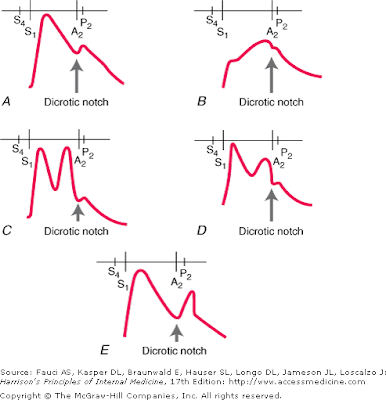pulsatile, expansible abdominal, mass: aortic aneurysm
large, tender liver: heart failure, constrictive pericarditis
systolic hepatic pulsation: TR
palpable spleen: severe heart failure, infective endocarditis
ascites: heart failure, constrictive heart failure (especially when ascites is out of proportion of limbs edema)
extremities:
ankle-brachial index (ABI): consider to be abnormal when <0.9, critical stenosis when < 0.3
thrombophlebitis: pain in the calf or thigh, with edema
arterial pressure pulse:
pulsus parvus: small weak pulse, common condition with decreased cardiac output
pulsus tardus: delayed systolic pulse, severe AS
pulsus bisferiens: two systolic peak, AR, or hypertrophic cardiomyopathy
pulsus alternans: regular rhythm with regular alternation of the pressure pulse amplitude, severe impairment of
LV function
pulsus paradoxus: systolic pressure decreased> 10 mmHg when inspiration, cardiac temponade, severe
lung disease, severe vena cava obstruction
a: atrial contraction
c: TV bulging into RA when RV isovolumetric systole
x: atrial relaxation when RV contraction
v: right atrial volume increased when RV systole and TV close
y: RV pressure decline and TV open
abdominal-jugular reflex: increased upper level of venous pulsation when abdominal compression (>10 seconds), indicate heart failure or TR
Kussmaul sign: increased rather than decreased CVP level during inspiration, indicate severe right-heart
failure
Precordial palpation:
normal LV apex impulse: mid-clavicular line, 4th or 5th intercostal space
LV hypertrophy: lateral and downward displacement of LV apex impulse
RV hypertrophy: sustained systolic lift at lower left sternal border
MR: left parasternal lift due to RV anterior displacement (compressed by enlarged LA)
visible or palpable pulmonary flow over the left 2nd intercostal space: pulmonary hypertension


.gif)